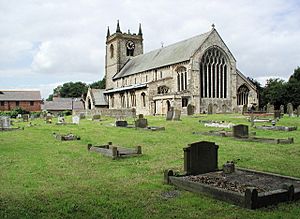Swine Priory facts for kids
Swine Priory was an old monastery for nuns in the village of Swine, England. It was located in the area known today as the East Riding of Yorkshire. This important historical site, which was once a Cistercian nunnery, is now protected as a Scheduled Monument.
The nunnery existed for a long time, from the 1100s until 1539. Not much of the original buildings are left today. However, you can still see the shapes in the ground where buildings once stood. There are also remains of old fishponds, drains, and a moat. A part of the priory's church was used to build the Church of St Mary that stands there now.
Contents
What Was Swine Priory?
Swine Priory was a special kind of monastery called a nunnery. This means it was a place where women, known as nuns, lived together. They dedicated their lives to religious worship and prayer. The nuns at Swine Priory followed the rules of the Cistercian order. This was a group of monks and nuns who lived very simple lives.
The Priory's Beginnings
The nunnery was started in the 1100s by a person named Robert de Verli. It was connected to another important monastery called Fountains Abbey. When it first began, there were 14 nuns and a leader called a prioress. The priory was dedicated to the Virgin Mary.
In 1177, Pope Alexander III sent a special letter called a papal bull. This letter officially approved the Cistercian rules for the priory. By 1181, when King Henry II confirmed the priory, it had grown. It included a master, canons (priests), brothers, and nuns.
Life at the Priory
Over time, there were some concerns about how men and women lived separately at the priory. People felt the separation was not strict enough. In 1404, a rich bishop named Walter Skirlaw left £100 to the nuns of Swine in his will. This was a lot of money back then! The priory also had some disagreements with a nearby monastery called Meaux Abbey.
The End of the Priory
Swine Priory closed down in 1539. This happened during a time called the dissolution of the monasteries. This was when King Henry VIII closed many monasteries across England. When Swine Priory officially closed on September 9, 1539, there was one prioress and 19 nuns living there.
The Church of St Mary
The Church of St Mary was built around 1180. It was the main church for the priory. The church building you see today still has parts of the original nunnery church. The old church was about 25 meters (82 feet) long.
What Remains Today?
Even though most of the buildings are gone, you can still see signs of the priory. There are earthworks, which are shapes in the ground. These show where the old buildings used to be. For example, there was a four-sided cloister, which was a courtyard surrounded by covered walkways. This cloister was surrounded by a moat. The moat was up to 2 meters (6.5 feet) deep and 5 to 10 meters (16 to 33 feet) wide. There were also drains and a series of fishponds. You can even see evidence of ridge and furrow, which are patterns in the ground from old farming methods.


